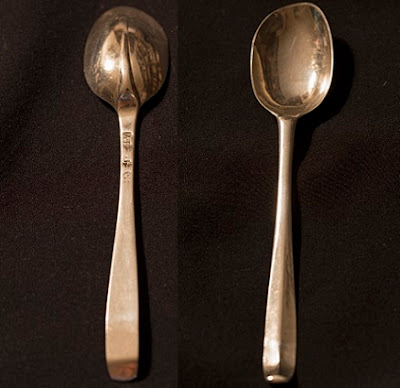I purchased this teaspoon several weeks ago. Thin and light, with a worn and wonky bowl, it won't be featured on the cover of a book any time soon. There are no initials or crest, but I also don't see signs of erasure. The spoon handle is quite narrow, and I'm not sure if this is the way it was made or if it was trimmed down at some later point.
The maker's mark appears to be AL with a pellet between, which I have attributed to Anthony Lefebure. Jackson's lists "spoon" as articles made by this silversmith, making this attribution slightly less tenuous. The base of the crown is just visible above the letters.
The spoon is also stamped with the harp crowned and Hibernia. Jackson's is very helpful, in that it has photographs of the Dublin silver hallmarks beginning with the 1720 date letter in its Appendix 1. The Hibernia on this teaspoon matches very closely with the photograph of Hibernia depicted for the year 1731.
So, is this the real deal? Having been caught out once before buying a piece of fake Irish silver, I'm hoping it's not a case of "fool me twice, shame on me."
Sources:
Pickford, Ian, ed. Jackson's Silver & Gold Marks of England, Scotland & Ireland. 3rd ed., 1989. Woodbridge:
The Antique Collectors' Club, Ltd., 2011. Print.

